Dielectric and Bioimpedance Research Studies: A Scientometric Approach Using the Scopus Database
Abstract
:1. Introduction
2. Materials and Methods
3. Results
3.1. Types and Languages of Publications
3.2. Evolution of Scientific Output
3.3. Publication Distribution by Countries and Institutions
3.4. Distribution of Output in Subject Categories and Journals
3.5. Analysis of Author Keywords and Index Keywords
4. Discussion and Conclusions
Acknowledgments
Author Contributions
Conflicts of Interest
References
- Pliquett, U. Bioimpedance: A review for food processing. Food Eng. Rev. 2010, 2, 74–94. [Google Scholar] [CrossRef]
- El Khaled, D.; Castellano, N.N.; Gázquez, J.A.; Perea-Moreno, A.J.; Manzano-Agugliaro, F. Dielectric Spectroscopy in Biomaterials: Agrophysics. Materials 2016, 9, 310. [Google Scholar] [CrossRef] [PubMed]
- Żywica, R.; Pierzynowska-Korniak, G.; Wójcik, J. Application of food products electrical model parameters for evaluation of apple purée dilution. J. Food Eng. 2005, 67, 413–418. [Google Scholar] [CrossRef]
- Vozáry, E.; Jócsák, I.; Droppa, M.; Bóka, K. Connection between Structural Changes and Electrical Parameters of Pea Root Tissue under Anoxia; Padilla, P., Ed.; World’s Largest Science, Technology & Medicine Open Access Book Publisher: London, UK, 2011; p. 131. [Google Scholar]
- Sanchez, B.; Bandarenka, A.S.; Vandersteen, G.; Schoukens, J.; Bragos, R. Novel approach of processing electrical bioimpedance data using differential impedance analysis. Med. Eng. Phys. 2013, 35, 1349–1357. [Google Scholar] [CrossRef] [PubMed]
- Harker, F.R.; Forbes, S.K. Ripening and development of chilling injury in persimmon fruit: An electrical impedance study. N. Z. J. Crop Hortic. Sci. 1997, 25, 149–157. [Google Scholar] [CrossRef]
- Hayden, R.I.; Moyse, C.A.; Calder, F.W.; Crawford, D.P.; Fensom, D.S. Electrical impedance studies on potato and alfalfa tissue. J. Exp. Bot. 1969, 20, 177–200. [Google Scholar] [CrossRef]
- Privé, J.P.; Zhang, M.I.N. Estimating cold stress inBeautiful Arcade’apple roots using electrical impedance analysis. HortTechnology 1996, 6, 54–58. [Google Scholar]
- Zhang, M.I.N.; Willison, J.H.M. Electrical Impedance Analysis in Plant Tissues11. J. Exp. Bot. 1991, 42, 1465–1475. [Google Scholar] [CrossRef]
- Montoya, M.M.; Lopez-Rodriguez, V.; De La Plaza, J.L. An improved technique for measuring the electrical conductivity of intact fruits. LWT Food Sci. Technol. 1994, 27, 29–33. [Google Scholar] [CrossRef]
- El Khaled, D.; Castellano, N.N.; Gazquez, J.A.; Salvador, R.G.; Manzano-Agugliaro, F. Cleaner quality control system using bioimpedance methods: A review for fruits and vegetables. J. Clean. Prod. 2017, 140, 1749–1762. [Google Scholar] [CrossRef]
- Khaled, D.E.; Novas, N.; Gazquez, J.A.; Garcia, R.M.; Manzano-Agugliaro, F. Fruit and vegetable quality assessment via dielectric sensing. Sensors 2015, 15, 15363–15397. [Google Scholar] [CrossRef] [PubMed]
- Kundu, A.; Gupta, B. Broadband dielectric properties measurement of some vegetables and fruits using open ended coaxial probe technique. In Proceedings of the International Conference on Control, Instrumentation, Energy and Communication (CIEC), Calcutta, India, 31 January–2 February 2014; pp. 480–484. [Google Scholar]
- Wharmby, A.W. The application of the fractional calculus model for dispersion and absorption in dielectrics II. Infrared waves. Int. J. Eng. Sci. 2016, 104, 62–74. [Google Scholar] [CrossRef]
- Tan, F.K.; Hassan, J.; Wahab, Z.A. Electrical conductivity and dielectric behaviour of manganese and vanadium mixed oxide prepared by conventional solid state method. Eng. Sci. Technol. Int. J. 2016, 19, 2081–2087. [Google Scholar] [CrossRef]
- Nedielko, M.; Hamamda, S.; Alekseev, O.; Chornii, V.; Dashevskii, M.; Lazarenko, M.; Scherbatskyi, V. Mechanical, Dielectric, and Spectroscopic Characteristics of “Micro/Nanocellulose + Oxide” Composites. Nanoscale Res. Lett. 2017, 12, 98. [Google Scholar] [CrossRef] [PubMed]
- Subramanyam, K. Bibliometric studies of research collaboration: A review. J. Inf. Sci. 1983, 6, 33–38. [Google Scholar] [CrossRef]
- Moed, H.F.; Burger, W.J.M.; Frankfort, J.G.; Van Raan, A.F. The use of bibliometric data for the measurement of university research performance. Res. Policy 1985, 14, 131–149. [Google Scholar] [CrossRef]
- Glänzel, W.; Schubert, A.; Czerwon, H.J. A bibliometric analysis of international scientific cooperation of the European Union (1985–1995). Scientometrics 1999, 45, 185–202. [Google Scholar] [CrossRef]
- Montoya, F.G.; Baños, R.; Meroño, J.E.; Manzano-Agugliaro, F. The research of water use in Spain. J. Clean. Prod. 2016, 112, 4719–4732. [Google Scholar] [CrossRef]
- Min, M.; Märtens, O.; Parve, T. Lock-in measurement of bio-impedance variations. Measurement 2000, 27, 21–28. [Google Scholar] [CrossRef]
- Keshtkar, A. Virtual bladder biopsy using bio-impedance spectroscopy at 62.500 Hz–1.024 MHz. Measurement 2007, 40, 585–590. [Google Scholar] [CrossRef]
- Clemente, F.; Romano, M.; Bifulco, P.; Cesarelli, M. EIS measurements for characterization of muscular tissue by means of equivalent electrical parameters. Measurement 2014, 58, 476–482. [Google Scholar] [CrossRef]
- Sanchez, B.; Louarroudi, E.; Pintelon, R. Time–frequency analysis of time-varying in vivo myocardial impedance. Measurement 2014, 56, 19–29. [Google Scholar] [CrossRef]
- Zhang, Z.; Li, H.B.; Li, Z.H. A novelty digital algorithm for online measurement of dielectric loss factor of electronic transformers. Measurement 2013, 46, 1200–1207. [Google Scholar] [CrossRef]
- Sudheendran, K.; Pamu, D.; Krishna, M.G.; Raju, K.J. Determination of dielectric constant and loss of high-K thin films in the microwave frequencies. Measurement 2010, 43, 556–562. [Google Scholar] [CrossRef]
- Bossou, O.V.; Mosig, J.R.; Zurcher, J.F. Dielectric measurements of tropical wood. Measurement 2010, 43, 400–405. [Google Scholar] [CrossRef]
- Cataldo, A.; Piuzzi, E.; Cannazza, G.; De Benedetto, E.; Tarricone, L. Quality and anti-adulteration control of vegetable oils through microwave dielectric spectroscopy. Measurement 2010, 43, 1031–1039. [Google Scholar] [CrossRef]
- Ziegler, B.E. Methods for Bibliometric Analysis of Research: Renewable Energy Case Study. Ph.D. Thesis, Massachusetts Institute of Technology, Cambridge, MA, USA, 2009. [Google Scholar]
- Manzano-Agugliaro, F.; Alcayde, A.; Montoya, F.G.; Zapata-Sierra, A.; Gil, C. Scientific production of renewable energies worldwide: An overview. Renew. Sustain. Energy Rev. 2013, 18, 134–143. [Google Scholar] [CrossRef]
- Salmerón-Manzano, E.; Manzano-Agugliaro, F. Worldwide scientific production indexed by Scopus on Labour Relations. Publications 2017, 5, 25. [Google Scholar] [CrossRef]
- Bar-Ilan, J. Citations to the “Introduction to informetrics” indexed by WOS, Scopus and Google Scholar. Scientometrics 2010, 82, 495–506. [Google Scholar] [CrossRef]
- Mongeon, P.; Paul-Hus, A. The journal coverage of Web of Science and Scopus: A comparative analysis. Scientometrics 2016, 106, 213–228. [Google Scholar] [CrossRef]
- Aghaei Chadegani, A.; Salehi, H.; Yunus, M.M.; Farhadi, H.; Fooladi, M.; Farhadi, M.; Ale Ebrahim, N. A comparison between two main academic literature collections: Web of Science and Scopus databases. Asian Soc. Sci. 2013, 9, 18–26. [Google Scholar] [CrossRef]
- Archambault, É.; Campbell, D.; Gingras, Y.; Larivière, V. Comparing bibliometric statistics obtained from the Web of Science and Scopus. J. Am. Soc. Inf. Sci. Technol. 2009, 60, 1320–1326. [Google Scholar] [CrossRef]
- Rodrigues, R.S.; Taga, V.; Passos, M.F.D. Research Articles about Open Access Indexed by Scopus: A Content Analysis. Publications 2016, 4, 31. [Google Scholar] [CrossRef]
- Solomon, D. Types of open access publishers in Scopus. Publications 2013, 1, 16–26. [Google Scholar] [CrossRef]
- Vuong, Q.H.; Ho, T.M.; Vuong, T.T.; Nguyen, H.V.; Napier, N.K.; Pham, H.H. Nemo Solus Satis Sapit: Trends of Research Collaborations in the Vietnamese Social Sciences, Observing 2008–2017 Scopus Data. Publications 2017, 5, 24. [Google Scholar] [CrossRef]
- Montoya, F.G.; Alcayde, A.; Baños, R.; Manzano-Agugliaro, F. A fast method for identifying worldwide scientific collaborations using the Scopus database. Telemat. Inform. 2017. [Google Scholar] [CrossRef]
- Miguel, S.; Tannuri de Oliveira, E.F.; Cabrini Grácio, M.C. Scientific production on open access: A worldwide bibliometric analysis in the academic and scientific context. Publications 2016, 4, 1. [Google Scholar] [CrossRef]
- Gimenez, E.; Manzano-Agugliaro, F. DNA Damage Repair System in Plants: A Worldwide Research Update. Genes 2017, 8, 299. [Google Scholar] [CrossRef] [PubMed]
- Garrido-Cardenas, J.A.; Mesa-Valle, C.; Manzano-Agugliaro, F. Human parasitology worldwide research. Parasitology 2017, 1–14. [Google Scholar] [CrossRef] [PubMed]
- De la Cruz-Lovera, C.; Perea-Moreno, A.J.; de la Cruz-Fernández, J.L.; Alvarez-Bermejo, J.A.; Manzano-Agugliaro, F. Worldwide Research on Energy Efficiency and Sustainability in Public Buildings. Sustainability 2017, 9, 1294. [Google Scholar] [CrossRef]
- Garrido-Cardenas, J.A.; Manzano-Agugliaro, F. The metagenomics worldwide research. Curr. Genet. 2017, 63, 819–829. [Google Scholar] [CrossRef] [PubMed]
- Tsay, M.Y. A bibliometric analysis of hydrogen energy literature, 1965–2005. Scientometrics 2008, 75, 421–438. [Google Scholar] [CrossRef]
- Celiktas, M.S.; Sevgili, T.; Kocar, G. A snapshot of renewable energy research in Turkey. Renew. Energy 2009, 34, 1479–1486. [Google Scholar] [CrossRef]
- Montoya, F.G.; Montoya, M.G.; Gómez, J.; Manzano-Agugliaro, F.; Alameda-Hernández, E. The research on energy in Spain: A scientometric approach. Renew. Sustain. Energy Rev. 2014, 29, 173–183. [Google Scholar] [CrossRef]
- Choi, J.; Yi, S.; Lee, K.C. Analysis of keyword networks in MIS research and implications for predicting knowledge evolution. Inf. Manag. 2011, 48, 371–381. [Google Scholar] [CrossRef]
- Li, L.L.; Ding, G.; Feng, N.; Wang, M.H.; Ho, Y.S. Global stem cell research trend: Bibliometric analysis as a tool for mapping of trends from 1991 to 2006. Scientometrics 2009, 80, 39–58. [Google Scholar] [CrossRef]
- Garrido-Cardenas, J.A.; Mesa-Valle, C.; Manzano-Agugliaro, F. Trends in plant research using molecular markers. Planta 2017, 1–15. [Google Scholar] [CrossRef] [PubMed]
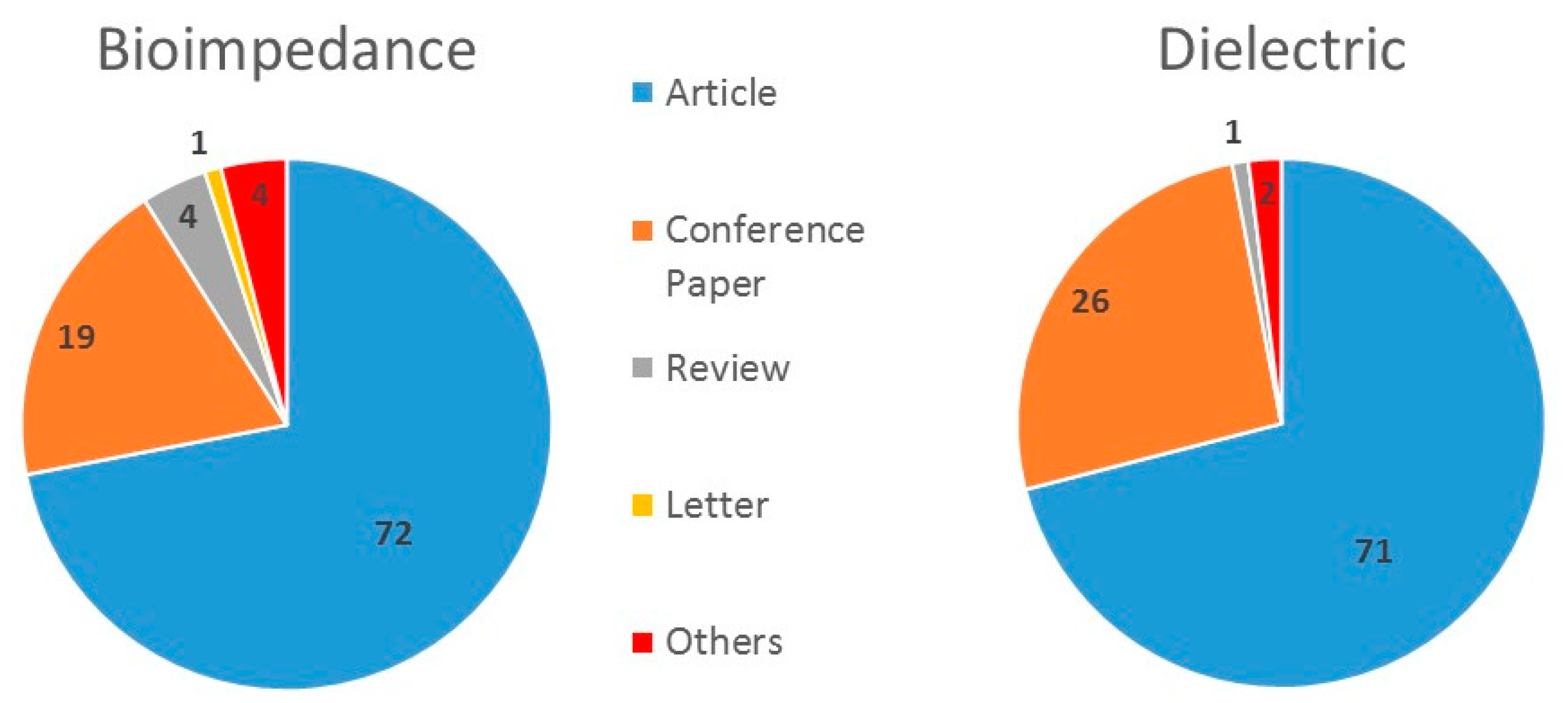
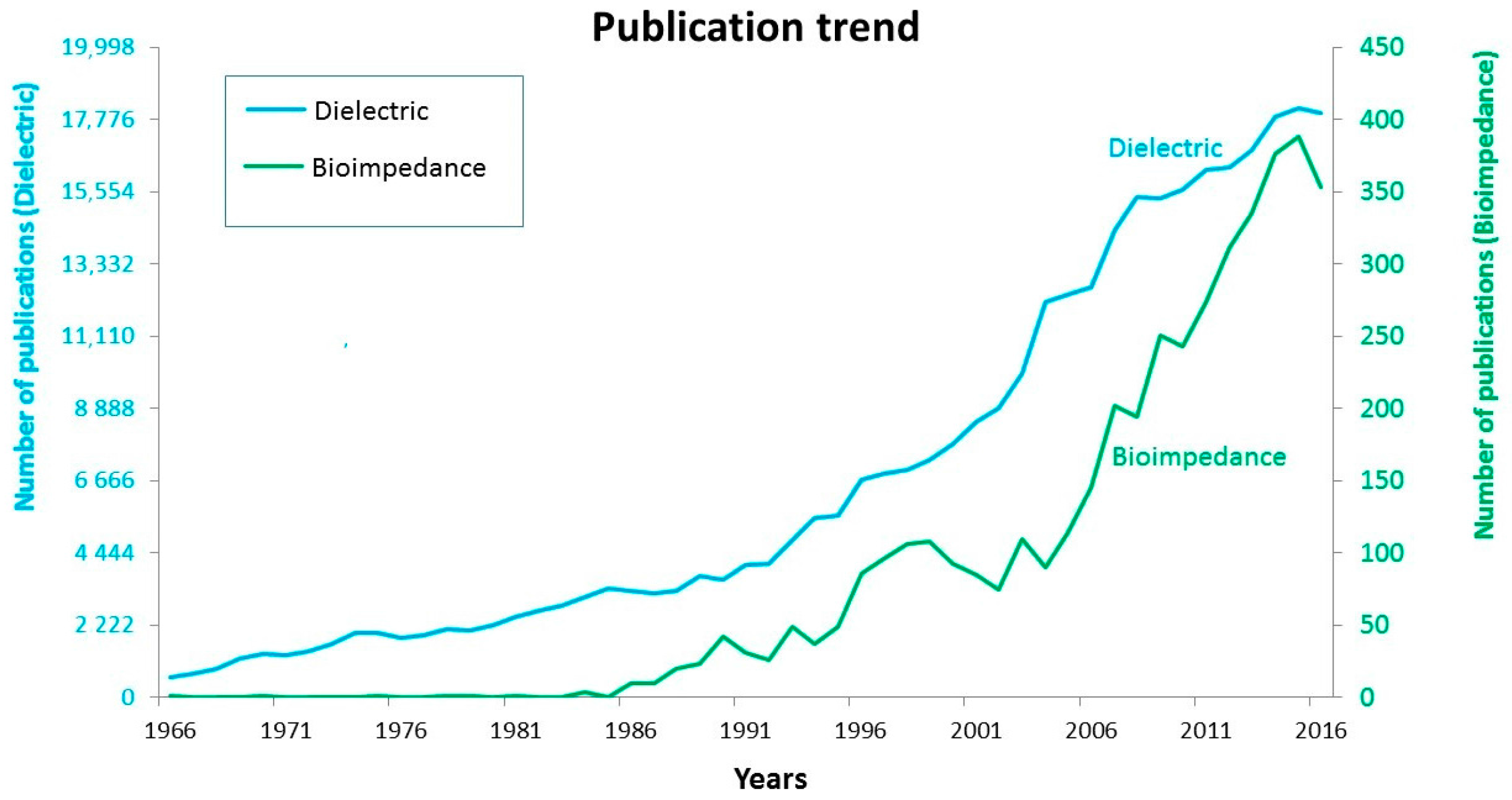
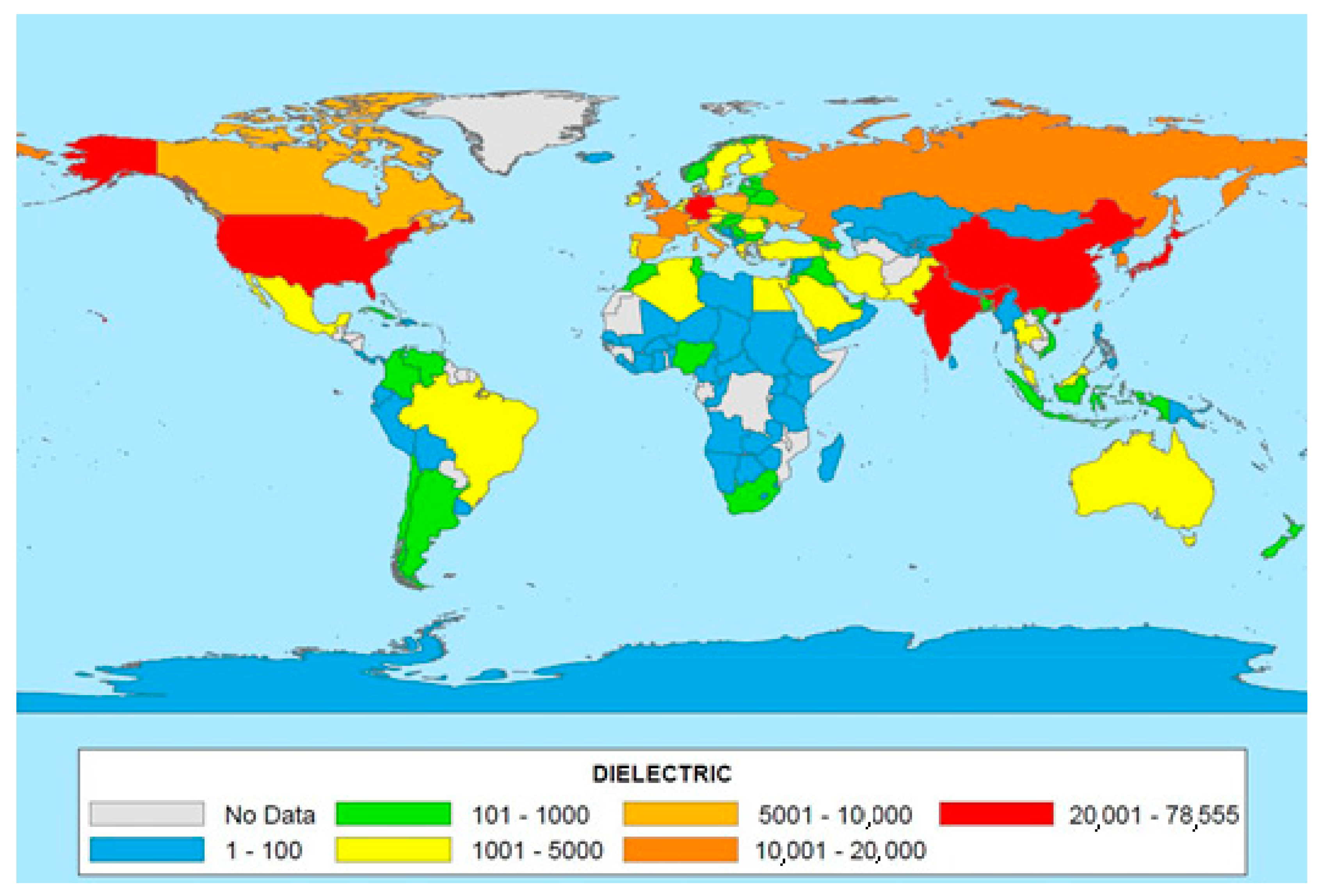
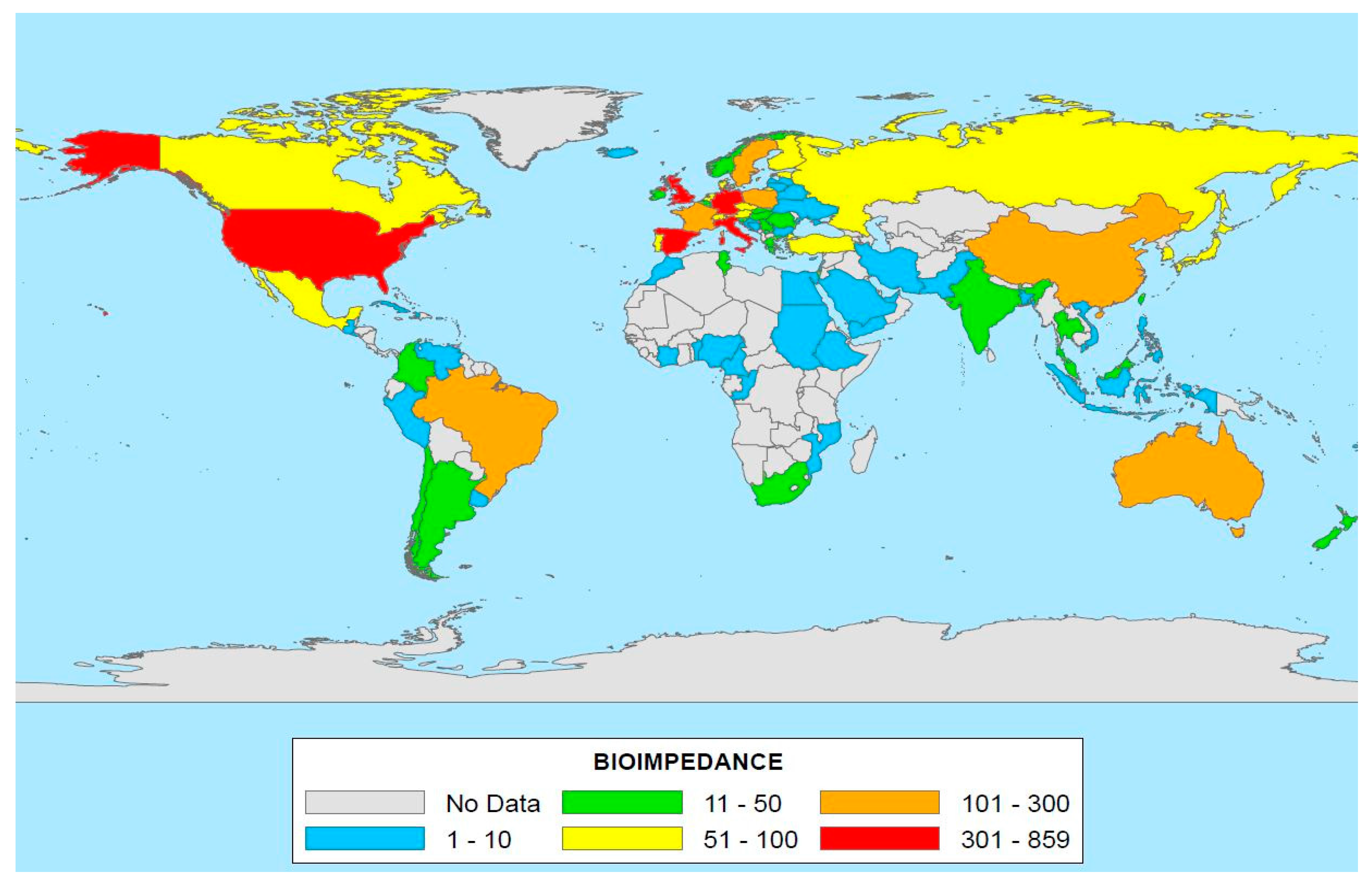
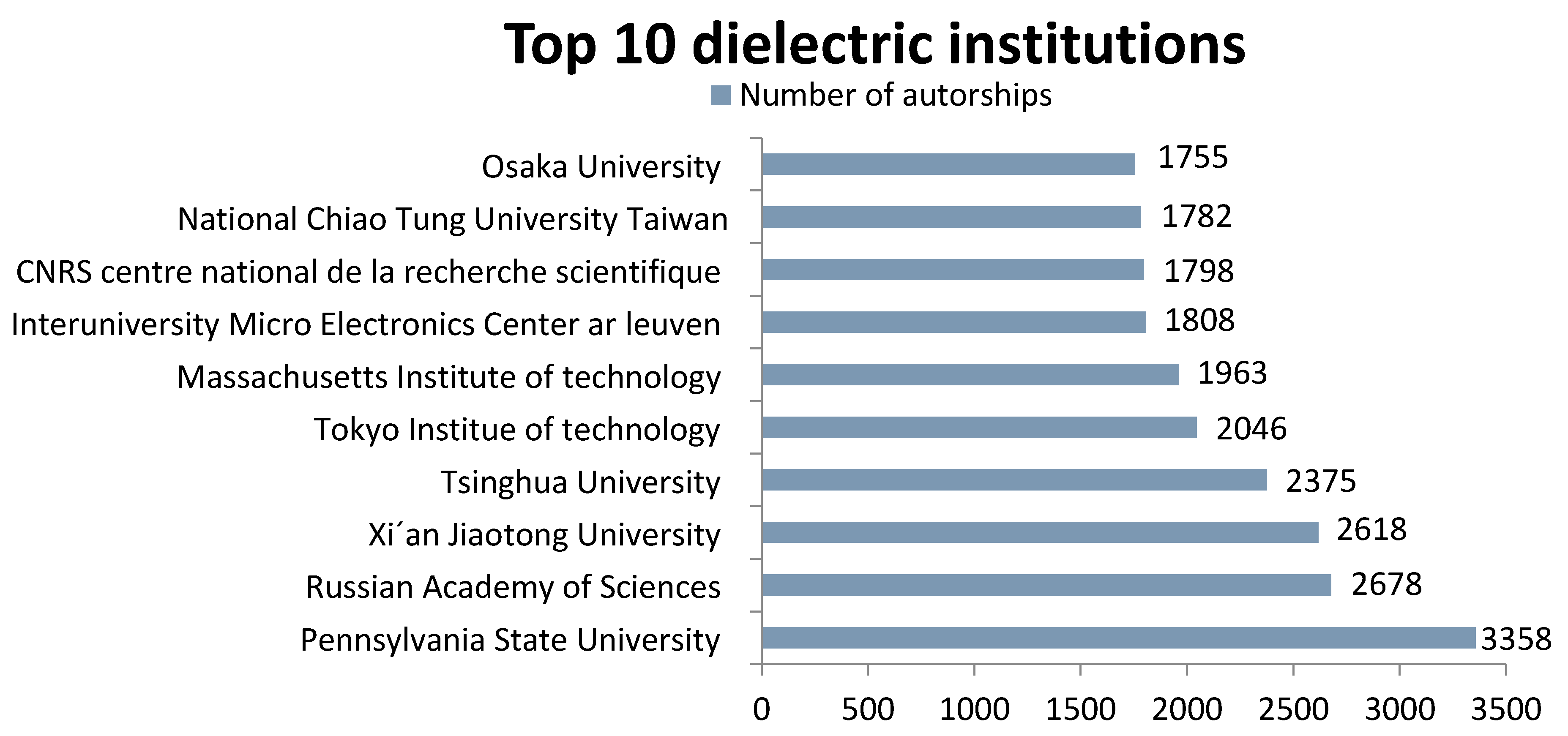

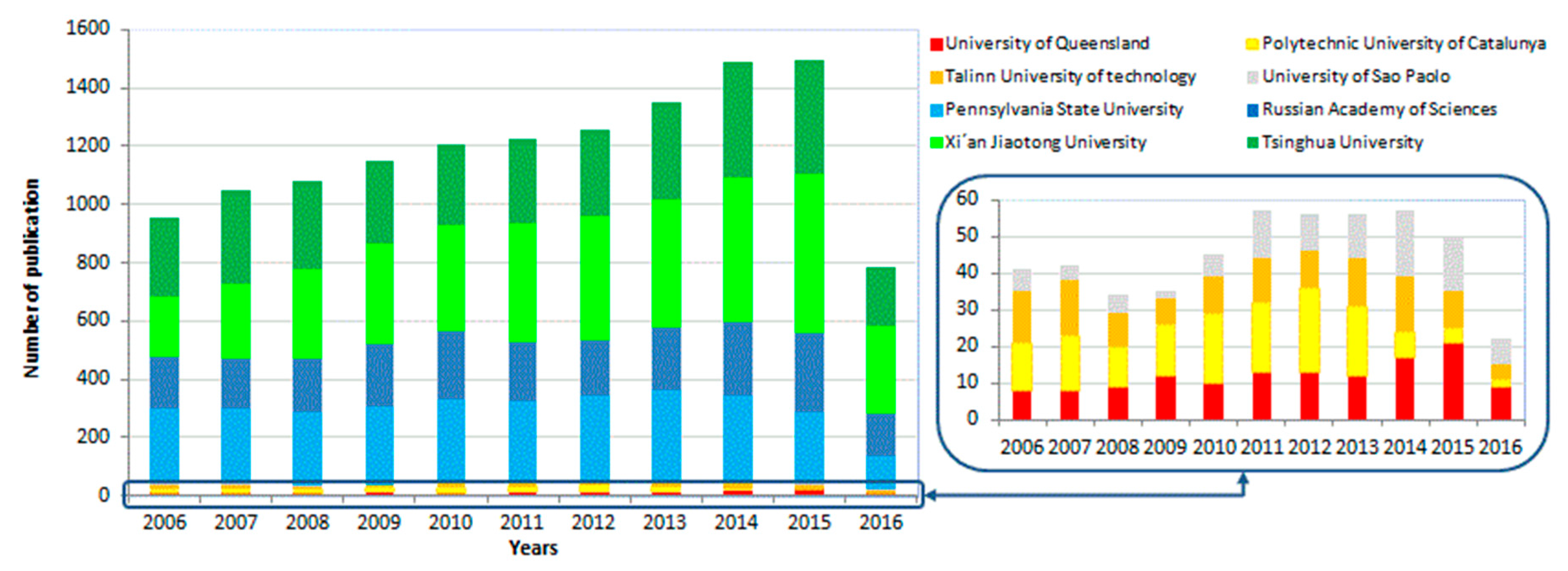
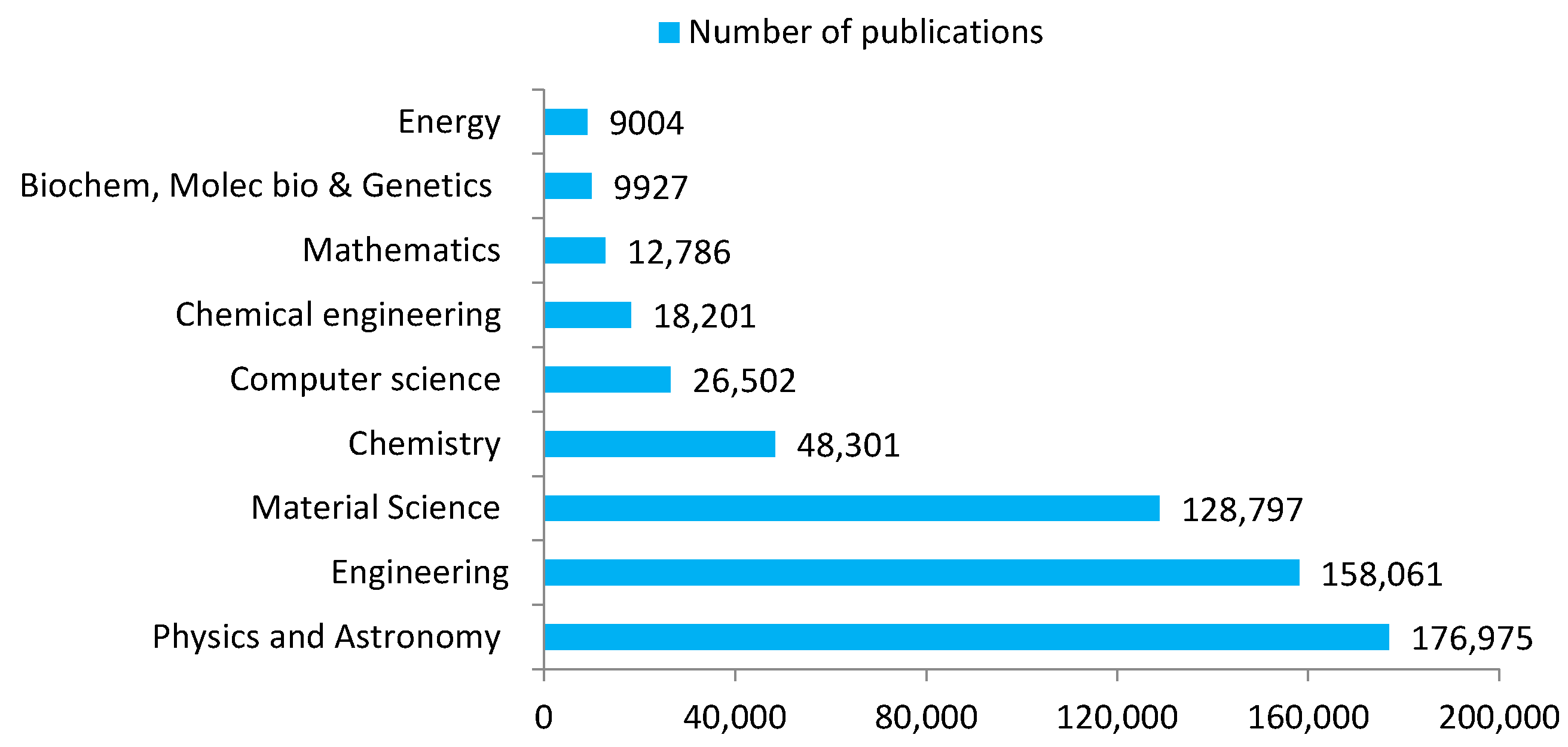
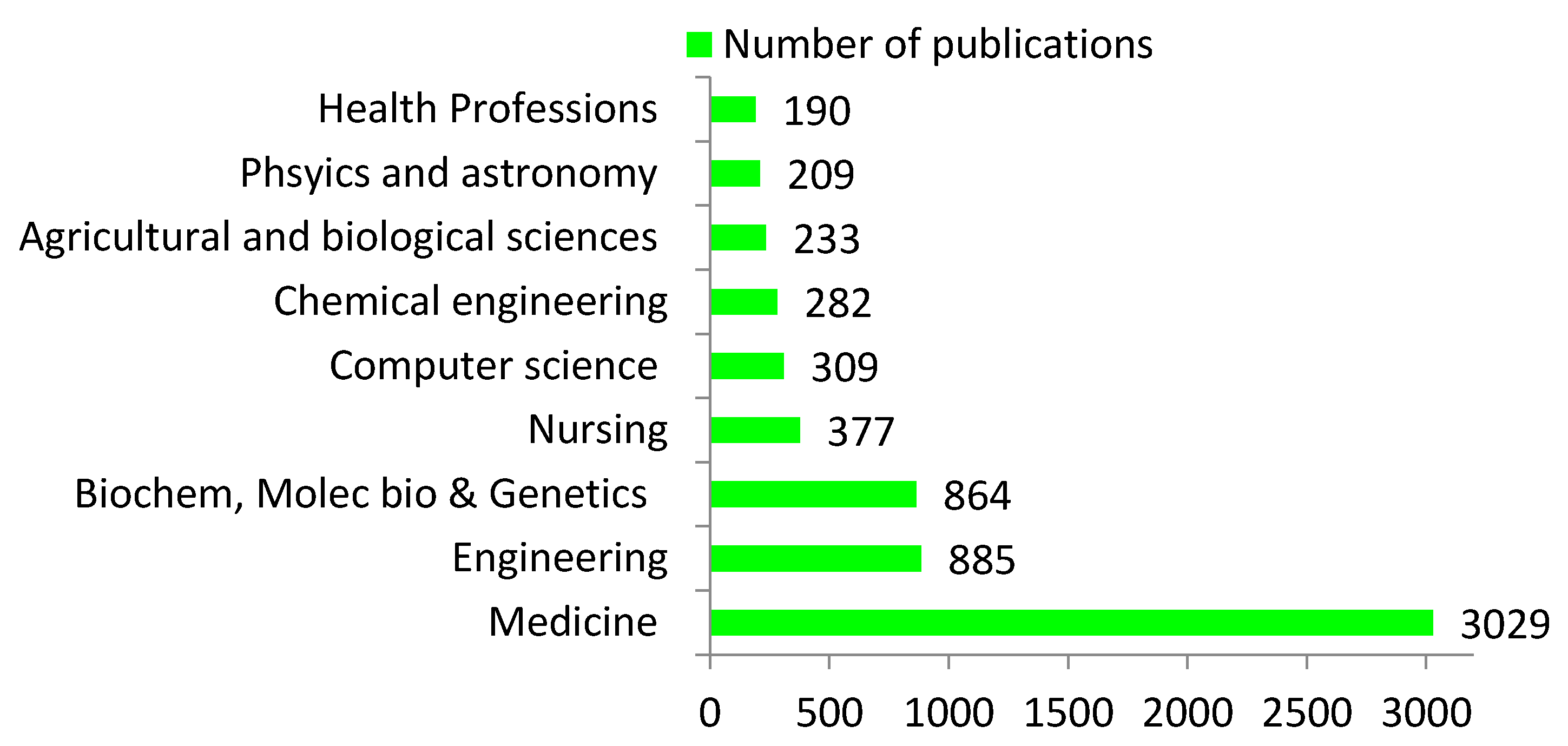
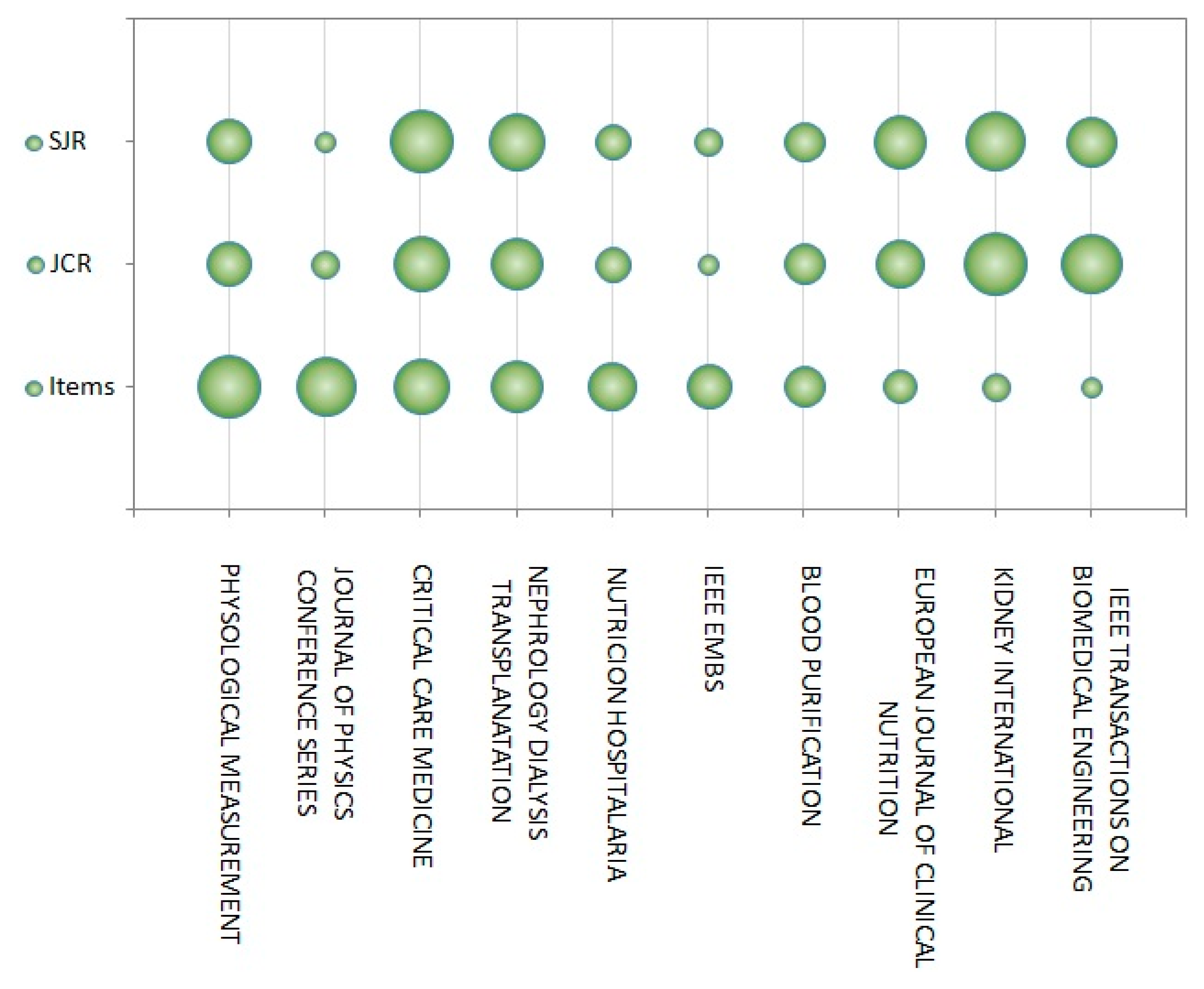
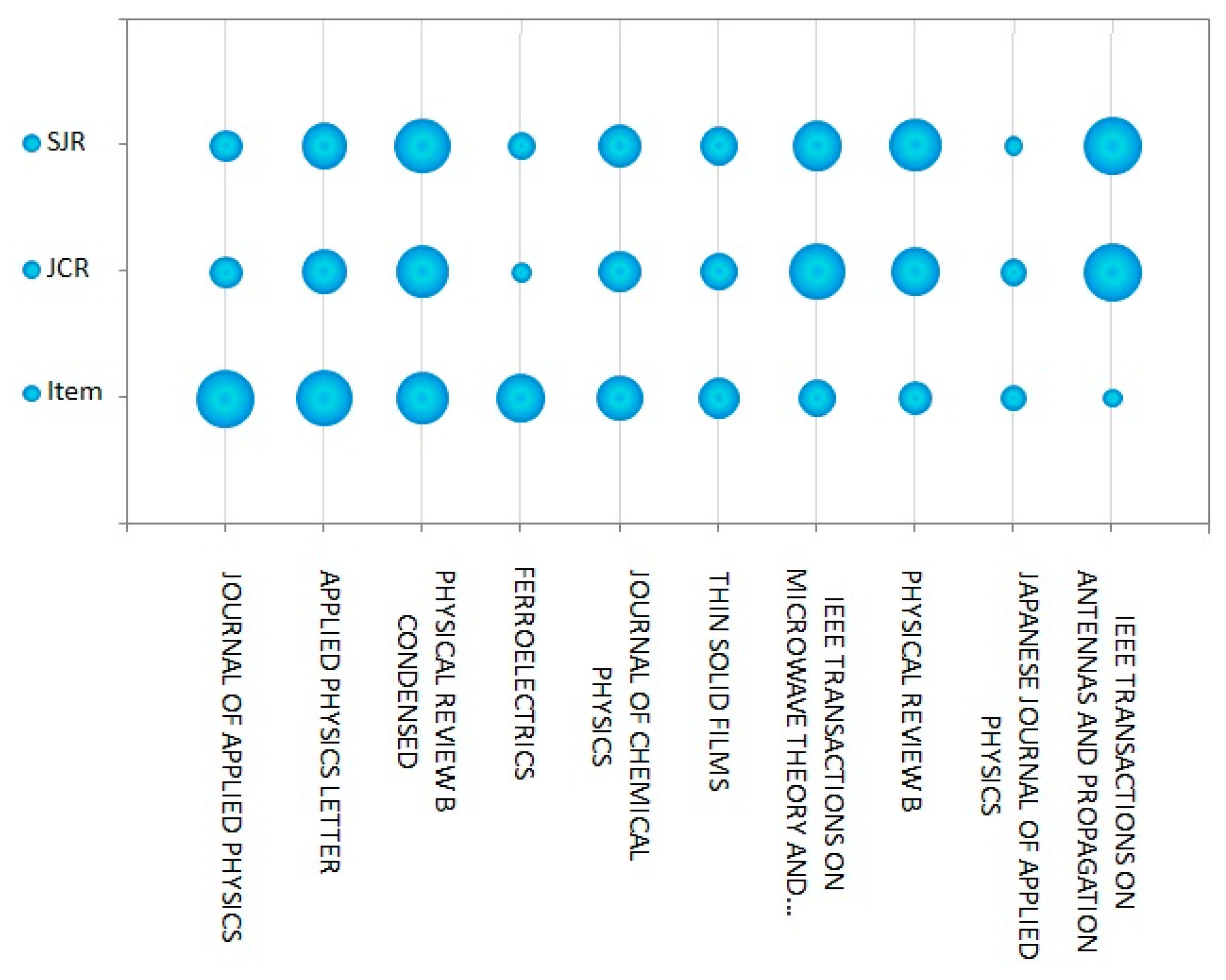
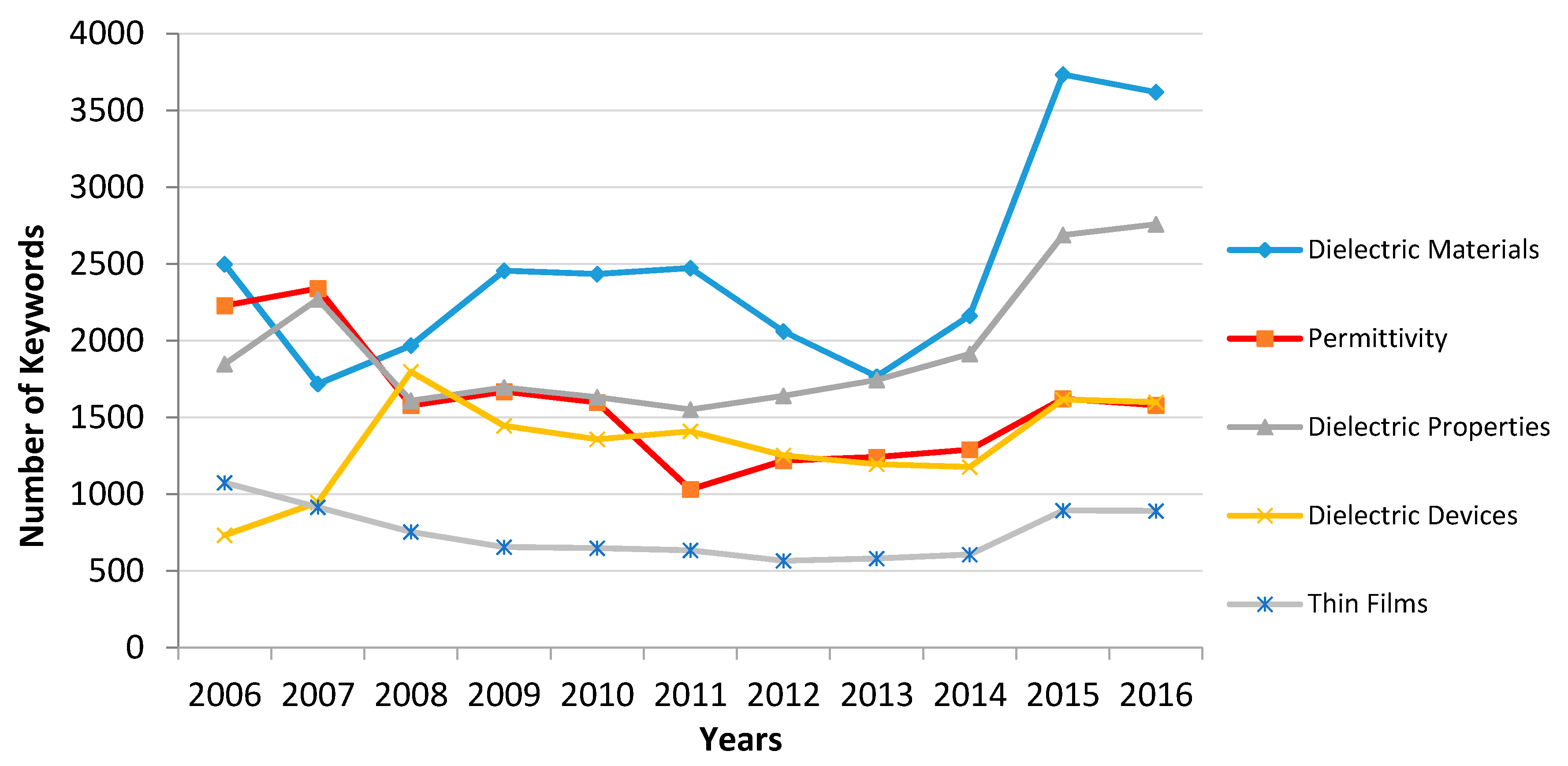
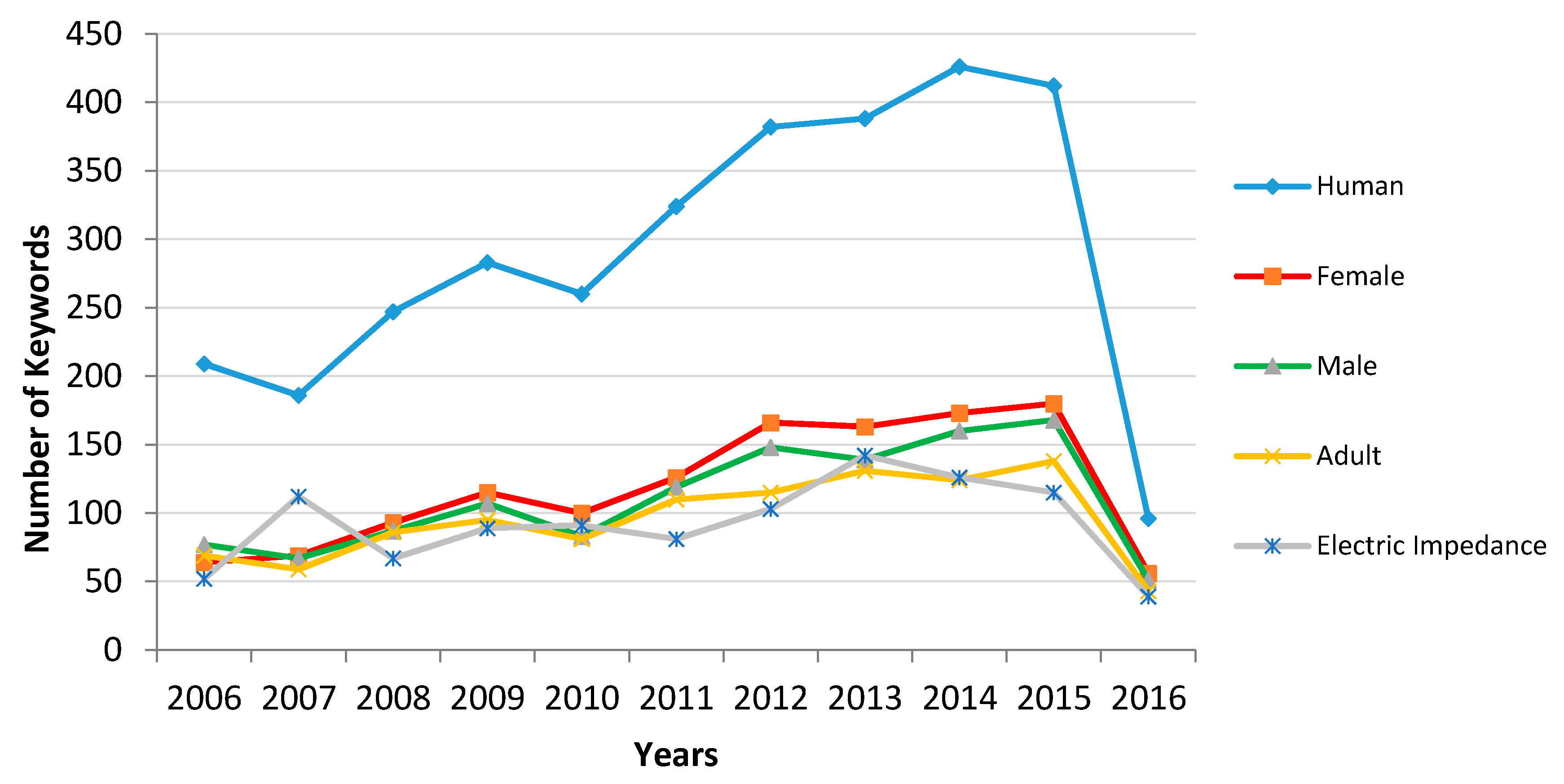
| Journal | Items | % | JCR | SJR | SNIP | Publisher | Ranking | ||
|---|---|---|---|---|---|---|---|---|---|
| Item | JCR | SJR | |||||||
| Journal of Applied Physics | 8070 | 20.44 | 1.66 | 0.603 | 0.755 | American Institute of Physics Publishing LLC | 1 | 8 | 8 |
| Applied Physics Letters | 7199 | 18.23 | 2.60 | 1.105 | 0.914 | American Institute of Physics Publishing LLC | 2 | 5 | 5 |
| Physical Reviewer B Condensed Matter and Materials | 3846 | 9.74 | 3.12 | 1.933 | 0.940 | American Physical Society | 3 | 3 | 2 |
| Ferroelectrics | 3446 | 8.73 | 0.56 | 0.264 | 0.433 | Taylor and Francis Ltd. | 4 | 10 | 9 |
| Journal of Chemical Physics | 3435 | 8.70 | 2.09 | 0.959 | 0.727 | American Institute of Physics Publishing LLC | 5 | 6 | 6 |
| Thin Solid Films | 3014 | 7.63 | 1.77 | 0.726 | 0.942 | Elsevier | 6 | 7 | 7 |
| IEEE Transactions on Microwave Theory and Techniques | 2758 | 6.99 | 3.16 | 1.346 | 2.029 | IEEE | 7 | 2 | 4 |
| Physical Review B | 2647 | 6.70 | 2.80 | 1.933 | 0.940 | American Physical Society | 8 | 4 | 3 |
| Japanese Journal of Applied Physics | 2601 | 6.59 | 0.64 | 0.258 | 0.467 | Japan Society of Applied Physics | 9 | 9 | 10 |
| IEEE Transactions on Antennas and Propagation | 2464 | 6.24 | 3.88 | 2.130 | 2.509 | IEEE | 10 | 1 | 1 |
| Journal | Items | % | JCR | SJR | SNIP | Publisher | Ranking | ||
|---|---|---|---|---|---|---|---|---|---|
| Item | JCR | SJR | |||||||
| Physiological Measurement | 114 | 20.28 | 2.09 | 0.795 | 1.263 | IOP Publishing Ltd. | 1 | 6 | 6 |
| Journal of Physics Conference Series | 77 | 13.70 | 0.39 | 0.211 | 0.247 | IOP Publishing Ltd. | 2 | 9 | 10 |
| Critical Care Medicine | 58 | 10.32 | 3.61 | 3.748 | 2.651 | Lippincott Williams and Wilkins | 3 | 4 | 1 |
| Nephrology Dialysis Transpalantation | 49 | 8.72 | 3.57 | 1.780 | 1.433 | Oxford University Press | 4 | 3 | 3 |
| Nutricion Hospitalaria | 49 | 8.72 | 1.39 | 0.386 | 0.746 | Grupo Aula Medica S.A. | 5 | 8 | 8 |
| IEEE EMBS | 48 | 8.54 | 0.38 | 0.215 | 0.319 | IEEE | 6 | 10 | 9 |
| Blood Purification | 43 | 7.65 | 1.40 | 0.609 | 0.677 | S. Karger AG | 7 | 7 | 7 |
| European Journal of Clinical Nutrition | 43 | 7.65 | 2.72 | 1.488 | 1.167 | Nature Publishing Group | 8 | 5 | 4 |
| Kidney International | 43 | 7.65 | 4.22 | 3.181 | 1.945 | Nature Publishing Group | 9 | 1 | 2 |
| IEEE transactions on Biomedical Engineering | 38 | 6.76 | 4.02 | 1.201 | 1.939 | IEEE Computer Society | 10 | 2 | 5 |
| Keywords | Items | % | Keywords | Items | % |
|---|---|---|---|---|---|
| Dielectric Materials | 50,033 | 12.77 | Refractive Index | 8610 | 2.20 |
| Permittivity | 36,469 | 9.31 | Electric Conductivity | 8538 | 2.18 |
| Dielectric Properties | 31,383 | 8.01 | Dielectric Relaxation | 8411 | 2.15 |
| Dielectric Devices | 18,138 | 4.63 | Dielectric Films | 8371 | 2.14 |
| Thin Films | 16,823 | 4.30 | Microwaves | 8235 | 2.10 |
| Ceramic Materials | 15,634 | 3.99 | Scanning Electron Microscopy | 8072 | 2.06 |
| Electric Fields | 14,021 | 3.58 | Capacitance | 7988 | 2.04 |
| Dielectric Constant | 12,898 | 3.29 | Ferroelectric Materials | 7967 | 2.03 |
| Dielectric Losses | 11,300 | 2.89 | Gate Dielectrics | 7908 | 2.02 |
| Conputer Simulation | 10,526 | 2.69 | Electrodes | 7892 | 2.01 |
| Mathematical Models | 10,507 | 2.68 | Electric Properties | 7811 | 1.99 |
| Polarization | 10,070 | 2.57 | Capacitors | 7372 | 1.88 |
| X Rat Diffraction | 9265 | 2.37 | Ferroelectricity | 7171 | 1.83 |
| Substrates | 8973 | 2.29 | Optical Properties | 6803 | 1.74 |
| Sintering | 8713 | 2.22 | Silicon | 6660 | 1.70 |
| Keywords | Items | % | Keywords | Items | % |
|---|---|---|---|---|---|
| Human | 4928 | 16.46 | Body Weight | 544 | 1.82 |
| Female | 1981 | 6.62 | Obesity | 543 | 1.81 |
| Male | 1906 | 6.36 | Bio-impedance | 476 | 1.59 |
| Adult | 1766 | 5.90 | Body Mass Index | 454 | 1.52 |
| Electric Impedance | 1515 | 5.06 | Anthropmetry | 411 | 1.37 |
| Impedance | 1486 | 4.96 | Body Fat | 401 | 1.34 |
| Priority Journal | 1307 | 4.36 | Adolescent | 396 | 1.32 |
| Body Composition | 1181 | 3.94 | Physiology | 378 | 1.26 |
| Middle Aged | 1152 | 3.85 | Body Water | 358 | 1.20 |
| Controlled Study | 1148 | 3.83 | Blood Pressure | 352 | 1.18 |
| Aged | 978 | 3.27 | Cardiac Output | 351 | 1.17 |
| Bioimpedance | 815 | 2.72 | Renal Dialysis | 350 | 1.17 |
| Clinical Article | 692 | 2.31 | Heart Output | 334 | 1.12 |
| Body Mass | 691 | 2.31 | Hemodialysis | 325 | 1.09 |
| Major Clinical Study | 688 | 2.30 | Hemdynamics | 315 | 1.05 |
© 2018 by the authors. Licensee MDPI, Basel, Switzerland. This article is an open access article distributed under the terms and conditions of the Creative Commons Attribution (CC BY) license (http://creativecommons.org/licenses/by/4.0/).
Share and Cite
El Khaled, D.; Novas, N.; Gazquez, J.-A.; Manzano-Agugliaro, F. Dielectric and Bioimpedance Research Studies: A Scientometric Approach Using the Scopus Database. Publications 2018, 6, 6. https://doi.org/10.3390/publications6010006
El Khaled D, Novas N, Gazquez J-A, Manzano-Agugliaro F. Dielectric and Bioimpedance Research Studies: A Scientometric Approach Using the Scopus Database. Publications. 2018; 6(1):6. https://doi.org/10.3390/publications6010006
Chicago/Turabian StyleEl Khaled, Dalia, Nuria Novas, Jose-Antonio Gazquez, and Francisco Manzano-Agugliaro. 2018. "Dielectric and Bioimpedance Research Studies: A Scientometric Approach Using the Scopus Database" Publications 6, no. 1: 6. https://doi.org/10.3390/publications6010006
APA StyleEl Khaled, D., Novas, N., Gazquez, J.-A., & Manzano-Agugliaro, F. (2018). Dielectric and Bioimpedance Research Studies: A Scientometric Approach Using the Scopus Database. Publications, 6(1), 6. https://doi.org/10.3390/publications6010006









